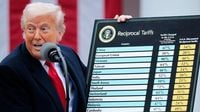The Organisation for Economic Co-operation and Development (OECD) delivered a sobering update on Tuesday, slashing its growth forecasts for the United States and the global economy amid the mounting impact of trade tensions and tariff policies. The Paris-based organization, comprising 38 of the world's most developed economies, highlighted that President Donald Trump's sweeping tariffs are significantly weighing on economic prospects, dampening growth and fueling inflationary pressures across multiple regions.
According to the OECD's latest Economic Outlook report, global GDP growth is projected to slow to 2.9% in both 2025 and 2026, a downward revision from the 3.1% and 3.0% previously forecasted for those years. This marks a notable deceleration from 3.3% growth recorded in 2024. The slowdown is primarily concentrated in the United States, Canada, Mexico, and China, where trade tensions and tariff hikes have disrupted supply chains and heightened economic uncertainty.
For the United States, the outlook is particularly grim. The OECD cut its growth forecast to just 1.6% for 2025 and 1.5% for 2026, down sharply from the 2.2% expansion expected earlier this year. This stark revision reflects the pervasive effects of the Trump administration's tariff policies, which have pushed the effective tariff rate on imports to 15.4%—the highest since 1938, up from a mere 2% last year. These tariffs have translated into higher costs for importers such as Walmart, who in turn pass these expenses onto consumers, contributing to rising inflation.
Inflation in the U.S. is expected to spike, with the OECD projecting a headline rate of 3.2% for 2025, up from 2.5% in 2024, and potentially nearing 4% by the year's end. This is despite the Consumer Price Index standing at 2.3% in April, before the full impact of tariffs had taken hold. OECD Chief Economist Álvaro Pereira underscored the role of increased trade barriers and policy uncertainty, stating, "We have seen a significant increase in trade barriers as well as in economic and trade policy uncertainty. This sharp rise in uncertainty has negatively impacted business and consumer confidence and is set to hold back trade and investment." The report also warns of risks skewed to the downside, including a more substantial economic slowdown, greater-than-expected inflationary pressures, and potential financial market corrections.
Globally, the OECD cautioned that additional tariff increases or prolonged policy uncertainty could exacerbate the slowdown and push inflation even higher. Secretary-General Mathias Cormann emphasized this point, noting, "Additional increases in trade barriers or prolonged policy uncertainty would further lower growth prospects and likely push inflation higher in countries imposing tariffs." He also highlighted that if the U.S. were to raise bilateral tariffs by an additional 10 percentage points on all countries beyond mid-May 2025 levels, global economic output could fall by 0.3% within two years, while U.S. output might drop by 0.6%.
China's economy, while affected by the U.S. tariff measures, is expected to see only a modest slowdown, with growth forecast at 4.7% in 2025 and 4.3% in 2026. This resilience is partly due to government subsidies for consumer goods trade-in programs and increased welfare spending. Meanwhile, economic growth in Canada and Mexico is also projected to slow, dropping from 1.5% in 2024 to 1.1% in 2025 for both countries.
Across the Atlantic, the euro area’s growth outlook remains steady at 1.0% for 2025 and 1.2% for 2026, buoyed by resilient labor markets, interest rate cuts, and increased public spending in Germany. However, the OECD's report does not shy away from highlighting the challenges posed by tariff-induced inflation and economic uncertainty globally.
Closer to home, the United Kingdom is grappling with its own economic headwinds. The OECD trimmed its forecast for UK growth to 1.3% in 2025, down from 1.4% predicted in March, citing the drag from U.S. tariff barriers and the burden of high interest payments on government debt. The UK faces particular fiscal challenges due to a "very thin" buffer in public finances. Chancellor Rachel Reeves is preparing to unveil her Spending Review in the week of June 9, 2025, where she must navigate tough decisions on departmental budgets amid competing priorities like defense and the National Health Service.
The OECD urged the UK government to adopt a "balanced approach" involving targeted spending cuts and tax increases to shore up public finances. Suggestions included closing tax loopholes and re-evaluating council tax bands, which are currently based on outdated property valuations from April 1991 in England and April 2003 in Wales. Despite a stronger-than-expected 0.7% growth in the first quarter of 2025, the OECD warned that "momentum is weakening" due to deteriorating business sentiment, forecasting a slowdown to 1.0% growth in 2026, down from 1.2% previously.
The OECD’s bleak outlook comes amid significant political and economic uncertainty. Bank of England Governor Andrew Bailey recently remarked that the global system of trade agreements has been "blown up to a considerable degree" by ongoing trade tensions. Meanwhile, President Trump, who has championed tariffs as a boon to the U.S. economy, posted on social media on June 3, 2025, "Because of Tariffs, our Economy is BOOMING!"—a claim at odds with official data showing the U.S. economy contracted by an annual rate of 0.2% in the first quarter of 2025, marking its first shrinkage since 2022.
While tariffs may incentivize domestic manufacturing, the OECD warns that higher import prices squeeze consumer purchasing power and dampen corporate investment amid policy uncertainty. The organization's analysis also points to the fiscal challenges posed by the Trump administration's sweeping tax cuts and spending bills, which are forecasted to push the U.S. budget deficit to 8% of economic output by 2026—an unusually large shortfall for a developed economy not engaged in war.
Looking ahead, the OECD sees potential for a "significant productivity revival" driven by advances in technology such as artificial intelligence, robotics, and quantum computing, particularly in the U.S., where exposure to AI is higher across sectors. However, such a revival hinges on resolving trade tensions and lowering barriers to boost investment and consumption.
OECD Secretary-General Mathias Cormann summed up the precarious state of the global economy: "The global economy has shifted from a period of resilient growth and declining inflation to a more uncertain path. Governments need to engage with each other to address any issues in the global trading system positively and constructively through dialogue." As the world navigates this challenging economic landscape, the stakes for policymakers and markets alike have never been higher.


